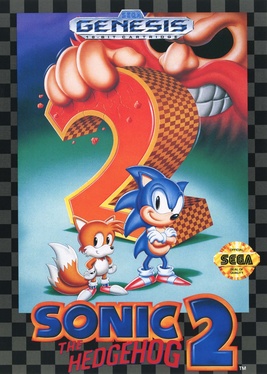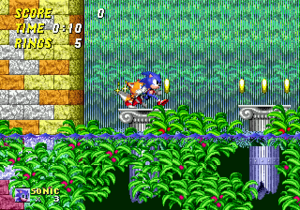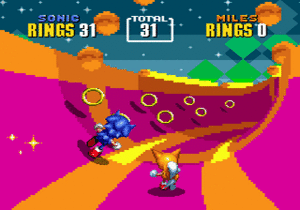Sonic the Hedgehog 2 (16-bit) facts for kids
Quick facts for kids Sonic the Hedgehog 2 |
|
|---|---|

US cover art by Greg Martin
|
|
| Developer(s) | Sega Technical Institute |
| Publisher(s) | Sega |
| Director(s) | Masaharu Yoshii |
| Producer(s) | Shinobu Toyoda |
| Designer(s) |
|
| Programmer(s) | Yuji Naka |
| Artist(s) |
|
| Composer(s) | Masato Nakamura |
| Series | Sonic the Hedgehog |
| Platform(s) | |
| Release date(s) |
November 21, 1992
Sega Genesis
|
| Genre(s) | Platform |
| Mode(s) | Single-player, multiplayer |
Sonic the Hedgehog 2 is a 1992 platform game developed by Sega Technical Institute (STI) for the Sega Genesis. It follows Sonic as he attempts to stop Doctor Robotnik from stealing the Chaos Emeralds to power his space station. Like the first Sonic the Hedgehog (1991), players traverse side-scrolling levels at high speeds while collecting rings, defeating enemies, and fighting bosses. Sonic 2 introduces Sonic's sidekick Miles "Tails" Prower and features faster gameplay, larger levels, a multiplayer mode, and special stages featuring pre-rendered 3D graphics.
Though the original Sonic the Hedgehog greatly increased the popularity of the Genesis in North America, Sega was slow to approve a sequel before directing STI founder Mark Cerny to start Sonic 2 in November 1991. Members of the original development team—including programmer Yuji Naka and designer Hirokazu Yasuhara—moved from Japan to California to join the project. Sonic 2 was intended to be faster and more ambitious than the first game. The development suffered setbacks, including language and cultural differences between the Japanese and American staff, and numerous levels were cut due to time constraints and quality concerns. As with the first game, Dreams Come True member Masato Nakamura composed the soundtrack.
Sonic 2 was widely anticipated, and Sega backed it with a $10 million marketing campaign. It was released in November 1992 to acclaim and received numerous year-end accolades. Critics considered Sonic 2 an improvement over the first game and praised the visuals, level design, gameplay, and music. The implementation of Tails and the multiplayer mode received criticism, while the special stages divided opinion. Sonic 2 broke video game sales records and grossed over $450 million in 1992. With six million copies sold worldwide, it is the second-bestselling Genesis game behind the original Sonic the Hedgehog.
Sonic 2 played a major role in keeping Sega competitive during the console wars of the fourth generation of video game consoles in the early 1990s. It continues to receive acclaim, often cited as one of the greatest video games of all time and one of the best Sonic games. Sonic the Hedgehog 3 and Sonic & Knuckles followed in 1994. Sonic 2 has been rereleased on various platforms via compilations and emulation, and a remake for iOS and Android devices, developed using the Retro Engine, was released in December 2013. A number of Sonic 2 prototypes have leaked since the game's release; the first, discovered in 1999, played a significant role in the development of the archaeogaming scene.
Gameplay
Sonic the Hedgehog 2 is a side-scrolling platform game. It features a story similar to the first Sonic the Hedgehog's (1991): Doctor Robotnik, a mad scientist, seeks the Chaos Emeralds to power his space station, the Death Egg, and traps the animal inhabitants of West Island in aggressive robots. As Sonic the Hedgehog, the player embarks on a journey to collect the Chaos Emeralds and stop Robotnik. The player character can run, jump, crouch, and attack by curling into a ball. Sonic 2 introduces the spin dash, which allows the player to curl while stationary for a speed boost, and Miles "Tails" Prower, a fox with two tails who acts as Sonic's sidekick. By default, the single-player controls both Sonic and Tails simultaneously; a second player can join in at any time and control Tails separately. The player can also choose to play as Sonic or Tails individually.
The game takes place across 11 zones with 20 levels ("acts"). The acts are larger than the first game's, and the player navigates them at high speeds while jumping between platforms, defeating robot enemies, and avoiding obstacles. Springs, slopes, bottomless pits, and vertical loops populate acts, as do hazards like water and spikes. The player passes checkpoints to save progress. The last act of each zone ends with a boss battle against Robotnik. The player collects rings as a form of health: if they have at least one ring when they collide with an enemy or obstacle, they will survive, but their rings will scatter and blink before disappearing. The player starts with three lives, which they lose if they are hit without a ring, fall down a pit, get crushed, drown, or reach the 10-minute time limit; they receive a game over if they run out. Power-ups like shields and invincibility provide additional layers of protection, and lives are replenished by collecting 100 rings or a 1-up.
If the player passes a checkpoint with 50 or more rings, they can warp to a special stage for an opportunity to collect one of the seven Chaos Emeralds. The player runs through a half-pipe course, collecting rings and dodging bombs. A set amount of rings must be collected to obtain the emerald. If the player collides with a bomb, they lose ten rings and are immobilized momentarily. The stages rise in difficulty and the player cannot enter any stage without passing the previous one. After finishing, the player is transported back to the star post they used to enter, with their ring count reset. When all the Chaos Emeralds have been collected, Sonic can transform into Super Sonic by collecting 50 rings. Super Sonic is nearly invincible, runs faster, and jumps farther, but loses one ring per second and reverts to normal when his rings are depleted.
Sonic 2 introduces a multiplayer game mode where two players compete against each other in a split-screen race across three levels. After one player finishes a level, the other player must finish within a minute. Players are ranked in five areas (score, time, rings held at the end of the level, total rings collected, and the number of item boxes broken). The player who excels in the most categories wins. Players can also compete to obtain the most rings in the special stages.
Knuckles in Sonic 2
Sonic & Knuckles was released in 1994, two years after Sonic 2. The Sonic & Knuckles game cartridge features a "lock-on" adapter that allows players to insert other Sega Genesis cartridges. Attaching Sonic 2 unlocks Knuckles the Echidna in Sonic the Hedgehog 2, a variation of Sonic 2 in which the player controls the Sonic the Hedgehog 3 (1994) character Knuckles the Echidna. The level design is identical, but Knuckles can glide and climb walls, allowing him access to areas inaccessible to Sonic or Tails. However, he cannot jump as high, making some areas, such as certain boss fights, more difficult.
Sales
Retailers preordered 2.2 million copies of Sonic 2 by October 1992, and it set a preorder record in Europe with 1.5 million game cartridges ordered in five countries, including 750,000 in the UK. Upon release, Sonic 2 broke video game sales records. In the US, it sold 600,000 copies within a day in addition to 400,000 preorders. It became the fastest-selling game in UK history with 750,000 copies sold within a day, grossing GB£27,000,000 or $47,000,000 (equivalent to $98,000,000 in 2022) and accounting for 48% of all UK software sales that week. It was the top-seller on Gallup's Sega charts for the UK, Japan, and US for two months, and the bestselling video game of 1992 in North America and Europe. The initial worldwide batch of 3.2 million cartridges sold out within two weeks.
Sonic 2 grossed $450 million in 1992 ($940 million adjusted for inflation), which Kalinske said was "more than any hit movie, more than any other entertainment property." The release-day revenue exceeded the total revenue that the bestselling rock music CD of 1992, Simply Red's Stars, had earned throughout the year. Sonic 2 appeared on UK sales charts well into 1993 and was the UK's second bestselling video game of 1993. By November 1993, it was the bestselling 16-bit video game at the time. Sonic 2 sold six million copies worldwide by August 2006, making it the second-bestselling Genesis game behind the original Sonic the Hedgehog.
Legacy
Sonic 2 was a major factor in keeping Sega competitive during the console wars of the fourth generation of video game consoles in the early 1990s, and GameSpot described it as the game that solidified Sonic as a major franchise. It boosted Genesis sales enough to nearly equalize Sega with Nintendo and cemented Sonic as a video game mascot on par with Nintendo's Mario. Further, the Sonic 2sday promotion has been credited for originating the concept of a concrete and unified worldwide release date for video games. The practice was uncommon before Sonic 2's release and became a widespread industry trend in the following years.
Sonic 2 introduced many elements that defined the Sonic franchise. Game Informer wrote that it "expanded the formula in myriad ways, giving Sonic new moves like the spin-dash, bigger stages to explore with more branching paths, and more inventive boss battles." USGamer said that much of the series' most-loved elements originated in Sonic 2 with the introduction of Tails, Super Sonic, and casino levels. Tails became one of the most popular Sonic characters; according to Nilsen, Sega found that Tails was as popular as Sonic because he received nothing but praise through its 800 number line. Tails starred in two spin-offs, Tails Adventure and Tails' Skypatrol, for the Game Gear in 1995.
Sonic 2 is frequently cited as one of the greatest video games of all time. Listing the game at number 71 in its Top 100 Games of All Time list in 2001, Game Informer wrote that Sonic 2 was "the most challenging and finely polished Sonic the Hedgehog title." Sonic 2 took first place in a survey conducted by Official Nintendo Magazine to determine the fan-favorite Sonic game in 2010, and GameZone named it the second-best Sonic game (behind Sonic 3) in 2011. GamesRadar+ named Sonic 2 the best Sonic game and the second-best Genesis game of all time (behind Streets of Rage 2 (1992)) in 2017. In November 2017, Sonic Team head Takashi Iizuka said that he felt Sonic 2 "really is the best of the classic Sonic series. The level design is just really, really solid... All of the [Sega] staff would say it was a great game for Japanese tastes but also a great game for American tastes. Sonic 2 really captured that global sense of game design and level design."
Influence
For Sonic's 20th anniversary in 2011, Sega released Sonic Generations, which features reimagined versions of stages from across the series' history. The PlayStation 3, Xbox 360, and Windows versions contain remakes of Sonic 2's Chemical Plant Zone and the Death Egg Robot boss fight, while the Nintendo 3DS version contains a remake of Casino Night. Additionally, a Casino Night-themed pinball minigame was released as downloadable content. Sonic Mania features reimagined versions of Chemical Plant and Oil Ocean, while Sonic Forces (2017) features a reimagined version of Chemical Plant. Some design elements from Sonic 2 feature in Studio Pierrot's Sonic the Hedgehog (1996) original video animation. The feature film Sonic the Hedgehog 2 (2022) draws inspiration from Sonic 2, though it is not a direct adaptation. The Death Egg Robot and Super Sonic appear in the film, while one of its posters recreates Martin's Sonic 2 box art illustration.
In the years since Sonic 2's release, a number of prototypes have been leaked online. In 1999, a Sonic fan, Simon Wai, discovered an early prototype containing the scrapped Hidden Palace, Wood, and Genocide City levels on a Chinese website and shared it with the Western Sonic fandom. The discovery played a significant role in the development of the archaeogaming scene, as it encouraged players to datamine games and document prototype ROM images so they could understand how popular games were developed. Journalist Heidi Kemps presented the prototype to Naka during a 2005 GameSpy interview and he identified it as originating from a preview cartridge that had been stolen from a 1992 New York City toy show. A Sonic fan discovered the Sonic 2 prototype featured on Nick Arcade in 2006 and raised over US$1,500 to buy the cartridge and release the ROM image online. The Nick Arcade prototype, while primitive and unpolished, showed fans how STI built the game atop the original Sonic the Hedgehog.
A high-definition (HD) fangame remake, Sonic 2 HD, entered development for Windows and macOS in 2008. The project was canceled in 2012 after the release of a game demo that Retro Gamer described as "blighted by programming incompetence", due to high system requirements and digital rights management that inadvertently triggered antivirus software. However, the project was restarted by a new team in 2014. It is planned to feature additional levels, multiplayer modes, and the option to play as Knuckles. Sonic 2 has also been noted for its active modding scene that releases ROM hacks featuring new game mechanics and playable characters. Modders decompiled the source code of the 2013 Sonic 2 remake in 2021, allowing it to be unofficially ported to any platform.
See also
 In Spanish: Sonic the Hedgehog 2 (Mega Drive) para niños
In Spanish: Sonic the Hedgehog 2 (Mega Drive) para niños



